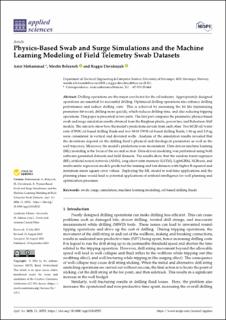| dc.contributor.author | Mohammad, Amir | |
| dc.contributor.author | Agonafir, Mesfin Belayneh | |
| dc.contributor.author | Davidrajuh, Reggie | |
| dc.date.accessioned | 2023-12-19T12:32:01Z | |
| dc.date.available | 2023-12-19T12:32:01Z | |
| dc.date.created | 2023-10-26T10:38:22Z | |
| dc.date.issued | 2023 | |
| dc.identifier.citation | Mohammad A, Belayneh M, Davidrajuh R. (2023) Physics-Based Swab and Surge Simulations and the Machine Learning Modeling of Field Telemetry Swab Datasets. Applied Sciences, 13(18):10252. | en_US |
| dc.identifier.issn | 2076-3417 | |
| dc.identifier.uri | https://hdl.handle.net/11250/3108200 | |
| dc.description.abstract | Drilling operations are the major cost factor for the oil industry. Appropriately designed operations are essential for successful drilling. Optimized drilling operations also enhance drilling performance and reduce drilling costs. This is achieved by increasing the bit life (minimizing premature bit wear), drilling more quickly, which reduces drilling time, and also reducing tripping operations. This paper is presented in two parts. The first part compares the parametric physics-based swab and surge simulation results obtained from the Bingham plastic, power law, and Robertson–Stiff models. The aim is to show how the model’s predictions deviate from each other. Two 80:20 oil/water ratio (OWR) oil-based drilling fluids and two 90:10 OWR oil-based drilling fluids, 1.96 sg and 2.0 sg, were considered in vertical and deviated wells. Analysis of the simulation results revealed that the deviations depend on the drilling fluid’s physical and rheological parameters as well as the well trajectory. Moreover, the model’s predictions were inconsistent. Data-driven machine learning (ML) modeling is the focus of the second section. Data-driven modeling was performed using both software-generated datasets and field datasets. The results show that the random forest regressor (RF), artificial neural network (ANN), long short-term memory (LSTM), LightGBM, XGBoost, and multivariate regression models predicted the training and test datasets with higher R-squared and minimum mean square error values. Deploying the ML model in real-time applications and the planning phase would lead to potential applications of artificial intelligence for well planning and optimization processes. | en_US |
| dc.language.iso | eng | en_US |
| dc.publisher | MDPI | en_US |
| dc.rights | Navngivelse 4.0 Internasjonal | * |
| dc.rights.uri | http://creativecommons.org/licenses/by/4.0/deed.no | * |
| dc.subject | oljebasert borevæske | en_US |
| dc.subject | maskinlæring | en_US |
| dc.title | Physics-Based Swab and Surge Simulations and the Machine Learning Modeling of Field Telemetry Swab Datasets | en_US |
| dc.type | Peer reviewed | en_US |
| dc.type | Journal article | en_US |
| dc.description.version | publishedVersion | en_US |
| dc.rights.holder | © 2023 by the authors | en_US |
| dc.subject.nsi | VDP::Teknologi: 500::Berg‑ og petroleumsfag: 510::Petroleumsteknologi: 512 | en_US |
| dc.source.volume | 13 | en_US |
| dc.source.journal | Applied Sciences | en_US |
| dc.source.issue | 18 | en_US |
| dc.identifier.doi | 10.3390/app131810252 | |
| dc.identifier.cristin | 2188710 | |
| dc.source.articlenumber | 10252 | en_US |
| cristin.ispublished | true | |
| cristin.fulltext | original | |
| cristin.qualitycode | 1 | |

